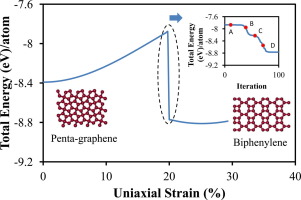The power of polymorphism in carbon is vividly manifested by the numerous applications of carbon-based nano-materials. Ranging from environmental issues to biomedical applications, it has the potential to address many of today’s dire problems. However, an understanding of the mechanism of transformation between carbon allotropes at a microscopic level is crucial for its development into highly desirable materials. In this work we report such a phase transformation between two carbon allotropes, from penta-graphene (a semiconductor) into biphenylene (a metal) under uniaxial loading. Using density functional theory we demonstrated that the phase transformation occurs through a synchronized reorganization of the carbon atoms with a simultaneous drop in energy. The results of this work confirms that penta-graphene is a meta-stable structure. On the other hand, a rigorous analysis of biphenylene suggests that it is an energetically, mechanically, dynamically and thermally stable structure, both in the form of a sheet and a tube. Its electronic structure suggests that it is metallic in both these forms. Therefore, this work unravels the possibility of phase transition in 2-D carbon systems and thereby designing nano-materials capable of altering their properties in an instant. Furthermore, heating biphenylene sheet at a high temperature (5000 K) revealed another phase transformation into a more stable hexa-graphene like structure. This proposes thermal annealing as a possible method of synthesizing one 2-D carbon allotrope from another.

The power of polymorphism in carbon is vividly manifested by the numerous applications of carbon-based nano-materials. Ranging from environmental issues to biomedical applications, it has the potential to address many of today’s dire problems. However, an understanding of the mechanism of transformation between carbon allotropes at a microscopic level is crucial for its development into highly desirable materials. In this work we report such a phase transformation between two carbon allotropes, from penta-graphene (a semiconductor) into biphenylene (a metal) under uniaxial loading. Using density functional theory we demonstrated that the phase transformation occurs through a synchronized reorganization of the carbon atoms with a simultaneous drop in energy. The results of this work confirms that penta-graphene is a meta-stable structure. On the other hand, a rigorous analysis of biphenylene suggests that it is an energetically, mechanically, dynamically and thermally stable structure, both in the form of a sheet and a tube. Its electronic structure suggests that it is metallic in both these forms. Therefore, this work unravels the possibility of phase transition in 2-D carbon systems and thereby designing nano-materials capable of altering their properties in an instant. Furthermore, heating biphenylene sheet at a high temperature (5000 K) revealed another phase transformation into a more stable hexa-graphene like structure. This proposes thermal annealing as a possible method of synthesizing one 2-D carbon allotrope from another.
